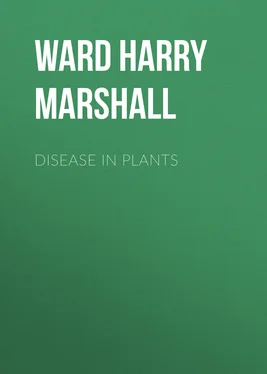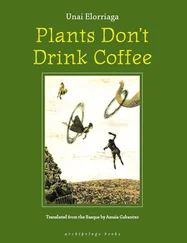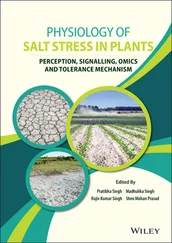Harry Ward - Disease in Plants
Здесь есть возможность читать онлайн «Harry Ward - Disease in Plants» — ознакомительный отрывок электронной книги совершенно бесплатно, а после прочтения отрывка купить полную версию. В некоторых случаях можно слушать аудио, скачать через торрент в формате fb2 и присутствует краткое содержание. Жанр: foreign_prose, Биология, Биология, foreign_edu, foreign_antique, на английском языке. Описание произведения, (предисловие) а так же отзывы посетителей доступны на портале библиотеки ЛибКат.
- Название:Disease in Plants
- Автор:
- Жанр:
- Год:неизвестен
- ISBN:нет данных
- Рейтинг книги:5 / 5. Голосов: 1
-
Избранное:Добавить в избранное
- Отзывы:
-
Ваша оценка:
- 100
- 1
- 2
- 3
- 4
- 5
Disease in Plants: краткое содержание, описание и аннотация
Предлагаем к чтению аннотацию, описание, краткое содержание или предисловие (зависит от того, что написал сам автор книги «Disease in Plants»). Если вы не нашли необходимую информацию о книге — напишите в комментариях, мы постараемся отыскать её.
Disease in Plants — читать онлайн ознакомительный отрывок
Ниже представлен текст книги, разбитый по страницам. Система сохранения места последней прочитанной страницы, позволяет с удобством читать онлайн бесплатно книгу «Disease in Plants», без необходимости каждый раз заново искать на чём Вы остановились. Поставьте закладку, и сможете в любой момент перейти на страницу, на которой закончили чтение.
Интервал:
Закладка:
The rock on which all are liable to come to grief—the chemist or physicist who requires all his facts in terms of analyses and proportions by weight, and therefore takes too mechanical a view of the subject, or the man who is not scientifically trained at all, and therefore is more liable to go to the other extreme and regard the plant as a mysterious something which grows and has poetical associations and traditions—is the great fact of organised structure, and it is the recognition of this fact and some of its consequences which has altered the whole position of the subject, and brought the study of the plant into the domain of physiology. The living plant, its structure and organisation, the functions of its mechanism, and its relations to the environment, thus forms a subject apart from that which concerns the chemical composition of the plant and its environment, and this distinction designates, in a word, as it were, the change which has been brought about by modern biology.
A point to be emphasised to the utmost where agricultural students are concerned is that the essential process of feeding is the same in a green plant, a fungus, and an animal; the greatest confusion still exists with regard to this matter, owing to misconceptions as to the real meaning of the functions of the chlorophyll-corpuscles when supplied with carbon-dioxide and water and the energy of the sun's rays. The plant does not feed on carbon-dioxide, any more than it feeds on oxygen—it feeds on the organic material after it has been constructed, and the chlorophyll-function is merely one mode of obtaining supplies of such organic substance.
Notes to Chapter II
In addition to the references in the last chapter, the student should consult Sachs' Lectures , XVII.-XIX., and Pfeffer's Physiology , pp. 287-329, for the further development of this subject. An excellent résumé, with new facts and points of view, will be found in Dr. Horace Brown's "Address to the Chemical Section," British Association Reports , Dover, 1899; and "Chemistry and Physiology of Foliage Leaves" in Trans. Chem. Soc. , 1893, p. 604. See also Blackman, "Experimental Researches on Vegetable Assimilation and Respiration," Phil. Trans. , 1895; and Parkin, "Formation, etc., of Carbohydrates in Monocotyledons," Phil. Trans. , 1899.
CHAPTER III.
THE PLANT A LIVING MACHINE
The plant a machine into which energy and material are taken—Carbon assimilation—Feeding—Accumulation and transformations in the plant. The action of light—The chlorophyll-function.
The relations of the plant to the environment can only be understood by taking into account the results of modern physiological discoveries. These teach us that the living plant is a highly complex machine, the details of its organisation and structure being much more numerous and much more closely correlated at numerous points, than the parts of any other machine known to us.
They also teach us that it is supplied with energy from without, as any other machine; and that when so supplied, and properly working, the living structure or machinery does work, also as other machines. But modern physiology goes further, in that it renders some account of the ways by which the external energy is taken into the plant, and there applied to do work, or stored up for a time in order that it may be used to do work at some future time.
The accumulation of energy thus ensured is associated with corresponding changes of material substance, and the principal means for bringing this about is recognised in the assimilation of carbon-dioxide—photo-synthesis.
In this process energy enters the chlorophyll-corpuscle in the form of the radiant energy of the sun, it is there directed in the mechanism of the protoplasm, so as to do work on the molecules of water and carbon-dioxide which have also been brought into the machinery; this it does, breaking asunder their stable structure into unstable bodies, which then re-combine in different ways to form a carbohydrate, such as starch, and this starch is temporarily stored as grains, while oxygen escapes.
Each starch-grain, therefore, is to be regarded as a packet of matter and of potential energy, as it were, capable of yielding up the latter at any future time, when put under such circumstances that it must do so. Such stores of energy-yielding substance, if I may use the much-abused phrase, form the principal food of the plant—or of an animal, if it steps in and takes them—and we now see that the process of carbon-dioxide assimilation, as it has perhaps unfortunately been called, is not the same thing as the process of feeding, for the feeding — i.e. the nutrition proper—of the plant does not begin until the food has been thus obtained.
We now see what the real position of the plant is, to its environment, whether the latter be living or dead. From our point of view, the plant serves as a centre for bringing together the substances obtainable from the soil, and those derived from the atmosphere, and so focussing and directing the radiant energy of the sun upon these substances, that they are broken up, and some of their constituents synthesised, with absorption of energy, into a body, such as starch, containing more energy than did the original substances taken together or separate. It matters little whether the actual carbohydrate thus synthesised is starch, or sugar or inulin: the point is that energy has been gained from outside and bound up with the acquired material for further use. But modern physiology has carried matters much further than this, and especially in the three following directions.
In the first place, it has shown that much of the energy thus stored from without in the plant is again liberated in the process of oxygen respiration, and expended partly as appreciable heat and partly as driving force for stimulating the machinery of the living plant to further activities.
In the second place, part of it is rearranged with the rearrangement of the molecules with which the energy is bound up, as it were, so that work of various kinds is done in the machinery of the plant: I refer to various metabolic and surface-actions resulting from the peculiar mode of presentment of the resulting substances, for instance the production of osmotic pressures in the cell.
And, thirdly, part of the synthesised substance is worked up into higher bodies, by processes which obviously entail the further doing of work on the constituents.
The further pursuit of this theme would evidently carry us beyond the more immediate subject of this book; but I want to make clear that recent researches render it more and more certain that the living plant is a complex piece of co-ordinated machinery which brings together matter and energy from the external universe, and then gets work out of these.
This proposition is the more important because the whole question of the enrichment of our planet with new food, new building materials, and new fuel, to compensate the daily losses, depends on it, and is of course to be referred fundamentally to the acquirement of new supplies of energy from the sun. Enormous activity has been displayed by physiologists, since 1860, in attempting to solve the question, which of the many different rays known to proceed from the sun are absorbed by the chlorophyll-corpuscle, and directed to the performance of the work above referred to.
The names of Draper, Sachs and Pfeffer stand forth prominently as pioneers in this; while those of Lommel, Engelmann, Timiriazeff and Langley have been among the most active in making important contributions to the subject, and in attempting to answer the further questions connected with the mode in which the chlorophyll is concerned in utilising the energy of the solar radiations. The point is one of supreme importance, because it goes on all fours with modern questions as to the rays of light absorbed or dispersed in our atmosphere at different seasons of the year, or in special climatic conditions, to say nothing of its other scientific aspects. Unfortunately, however, we have no satisfactory explanation of the actual rôle played by the chlorophyll substance itself, in spite of much industrious work which has been done in the subject in this country and elsewhere. As regards the rays employed, it was first proved that the most effective belong to the red end of the visible spectrum, and that the effect as measured by the amounts of oxygen given off, and of starch formed in given periods of time, is more or less proportionable to the intensity of the solar light. Then it was established that no monochromatic light is so powerful as the white light from which it was obtained, though the relative numbers expressing the activity in the red and yellow regions may stand to those in the blue as something like 12:1. The latest results place the maximum assimilation in the red-orange, and this coincides with the maximum absorption in the chlorophyll. If we may accept the current views as to the distribution of energy in the spectrum of solar light, which depends on the complete absorption of all the rays by a black body, where they are estimated as heat, we have the interesting result that the agricultural or forest plant is adapted to catch and retain, broadly speaking, just those particular rays which possess most energy.
Читать дальшеИнтервал:
Закладка:
Похожие книги на «Disease in Plants»
Представляем Вашему вниманию похожие книги на «Disease in Plants» списком для выбора. Мы отобрали схожую по названию и смыслу литературу в надежде предоставить читателям больше вариантов отыскать новые, интересные, ещё непрочитанные произведения.
Обсуждение, отзывы о книге «Disease in Plants» и просто собственные мнения читателей. Оставьте ваши комментарии, напишите, что Вы думаете о произведении, его смысле или главных героях. Укажите что конкретно понравилось, а что нет, и почему Вы так считаете.












